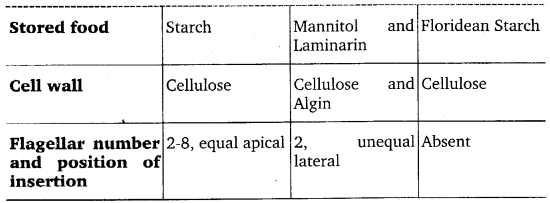Punjab State Board PSEB 11th Class Biology Important Questions Chapter 3 Plant Kingdom Important Questions and Answers.
PSEB 11th Class Biology Important Questions Chapter 3 Plant Kingdom
Very short answer type questions
Question 1.
Name the types of classification of plants.
Answer:
Artificial, natural and phylogenetic.
Question 2.
Which system indicates evolutionary as well as genetic relationships among organisms?
Answer:
Phylogenetic system of classification.
Question 3.
What is cytotaxonomy?
Answer:
Cytotaxonomy is a method of classification. It is based on cytological structure and their relatedness.
![]()
Question 4.
Food is stored as floridean starch in Rhodophyceae. Mannitol is the reserve food material of which group of algae?
[NCERT Exemplar]
Answer:
Phaeophyceae.
Question 5.
Holdfast, stipe and frond constitutes the plant body in case of
[NCERT Exemplar]
(a) Rhodophyceae
(b) Chlorophyceae
(c) Phaeophyceae
(d) All of these
Answer:
The lamina of Phaeophyceae members large sized body with differentiation of holdfast, stipe and lamina.
Question 6.
The plant body in higher plants is well differentiated and well developed. Roots are the organs used for the purpose of absorptions. What is the equivalent of the roots in the less developed lower plants? [NCERT Exemplar]
Answer:
Rhizoids.
Question 7.
Most algal genera show haplontic life cycle. Name an alga which is (i) Haplodiplontic (ii) Diplontic [NCERT Exemplar]
Answer:
Haplodiplontic: Ulva, Dictyota.
Diplontic: Fucus, Cladophora, Glomerata.
Question 8.
How are mosses considered ecologically important?
Answer:
Mosses, along with lichens are the first organism to colonise rocks, hence are ecologically important.
![]()
Question 9.
A prothallus is
(a) a structure in pteridophyte formed before the thallus develops
(b) a sporophytic free-living structure formed in pteridophyte
(c) a gametophytic free-living structure formed in pteridophytes
(d) a primitive structure formed after fertilisation in pteridophyte
[NCERT Exemplar]
Answer:
Gametophyte is a free-living small thalloid structure called prothallus. In most ferns, the prothallus is green and autotrophic.
Question 10.
Where are seeds located in gymnosperm?
Answer:
Seeds lie naked or exposed on the surface of megasporophyll.
Question 11.
The embryo sac of an angiosperm is made up of:
(i) 8 cells
(ii) 7 cells and 8 nuclei
(iii) 8 nuclei
(iv) 7 cells and 7 nuclei [NCERT Exemplar]
Answer:
(ii) Embryo sac of angiosperm develops up to 8 nucleate state prior to fertilisation. There is a three celled egg apparatus, three antipodal cells and two polar nuclei.
Question 12.
What is alternation of generations?
Answer:
Alernation of generations is regular switch over from gamete bearing haploid gametophyte to haploid spore producing diploid sporophyte.
![]()
Short answer type questions
Question 1.
What are the main differences among Chlorophyceae, Phaeophyceae and Rhodophyceae?
Answer:


Question 2.
What is the general structure of bryophytes?
Answer:
Structure of Bryophytes: It is thallus-like and prostrate or erect, and attached to the substratum by unicellular or multicellular rhizoids. They lack true roots, stem or leaves. They may possess root-like, or stem-like structures.
Question 3.
What is the general structure of pteridophytes?
Answer:
- The main plant body is a sporophyte which is differentiated into true root, stem and leaves. These organs possess well-differentiated vascular tissues.
- The leaves in pteridophyta are small (microphylls) as in Selaginella or large (macrophylls) as in ferns.
- The sporophytes bear sporangia that are subtended by leaf-like appendages called sporophylls. In some cases sporophylls may form distinct compact structures called strobili or cones (Selaginella, Equisetum).
![]()
Question 4.
Write short notes on:
(a) Importance of carbon fixation by algae.
(b) Importance of Gymnosperms
(c) Importance of Angiosperms
(d) Medicinal use of algae
Answer:
(a) About 50% of carbon fixation is done by algae. This enables majority of sea organisms to get the required food.
(b) Gymnosperms are mainly used as decorative plants. Certain paints are
prepared from Gymnosperm plants.
(c) Angiosperms are the major providers of food-grains to the mankind.
(d) Spirullina is made by algae and is used as a nutritional supplement.
Long answer type questions
Question 1.
Algae are known to reproduce asexually by a variety of spores under different environmental condition. Name these spores and the conditions under which they are produced. [NCERT Exemplar]
Answer:
Zoospores: Flagellate spores, under favourable conditions.
Aplanospores: Non-flagellate, thin-walled spores under approaching unfavourable conditions.
Hypnospores: Thick-walled, resting spores in unfavourable conditions.
Akinetes: Thin-walled and thick-walled spores formed from whole cells in unfavourable conditions. .
Autospores: Spores which look exactly like parent cell formed under favourable conditions.
Question 2.
Write about habit and habitat of algae.
Answer:
Habit and Habitat of Algae: Algae are chlorophyll-bearing, simple, thalloid, autotrophic and largely aquatic (both fresh water and marine) organisms. They occur in a variety of other habitats : moist stones, soils and wood. Some of them also occur in association with fungi (lichen) and animals (e.g., on sloth bear).
![]()
Question 3.
What are the differences betweenpinus and cycas?
Answer:
| Pinus | Cycas |
| 1. Roots are micorrhizal. | 1. Roots are not micorrhizal. |
| 2. Stems are branched. | 2. Stems are unbranched. |
| 3. Male and female strobili are on same tree. | 3. They are on different trees. |
